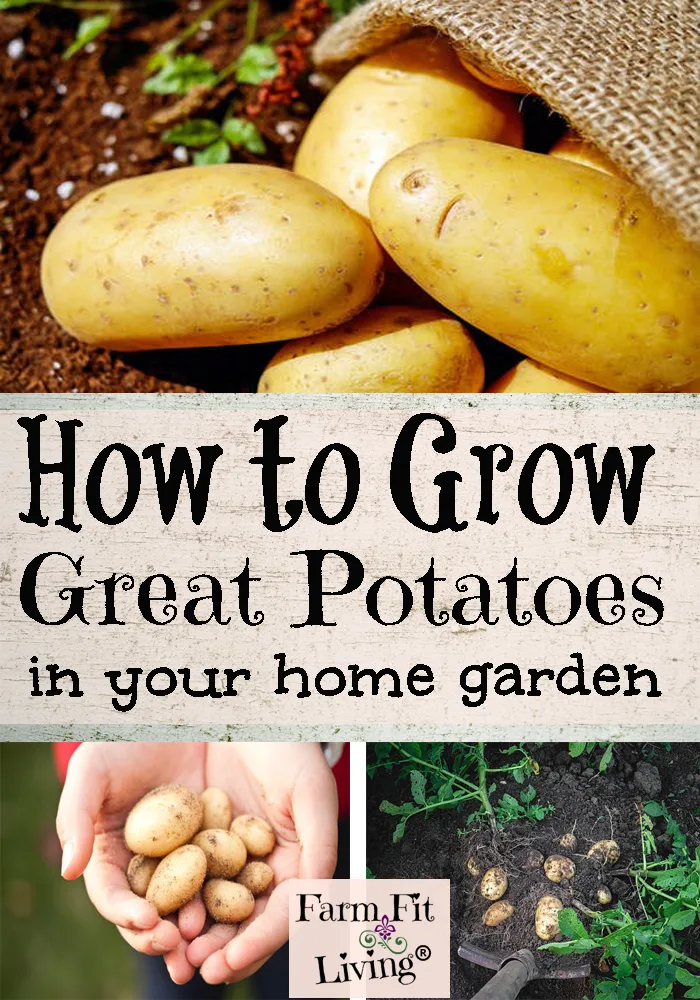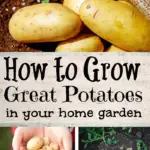Are you having trouble trying to grow great potatoes in your garden?
I have a secret to share with you…You don’t have to be Irish to grow great potatoes! That’s just silly. Anyone can grow great potatoes that keep well and taste amazing.
But there are some things you do need to know. You’re in the right place.
I’m going to share about soil health, mulching, spacing and all the other great tips I have used over the many years to grow great potatoes that will keep long term. I’ve been a gardener for 34 years now and potatoes have been one of the easiest veggies for me to grow.
In this post, I will discuss:
- Some great ways to grow great potatoes wherever you are.
- Growing potatoes in containers or in the garden.
- Answer common questions, such as “how long does it take to grow a potato.”

Soil for Potatoes
All potato varieties can be grown in nearly any type of soil. But I’m going to tell you the kind of soil for potatoes they PREFER to grow in.
Since potatoes are tubers or root crops, they grow best in a soft loamy or sandy soil that drain very well. If you plant them in a bed that doesn’t drain well, they will be stunted and rot underneath. The soil must be able to drain well.
Also, potatoes prefer a slightly acidic to alkaline range of soil pH. This gives a very wide range of possibility and proves that they can really be grown everywhere. The preferred pH is closer to 6 or 6.5 but they will tolorate the higher ranges of 7 to 8.
Remember: The best way to test for the pH and other nutrients for the perfect seed bed is to conduct a soil test. In the related posts below, I’m sharing my post for how to test your soil.
Another important step is to keep the soil fertile for growing. There is no such thing as potato magic fertilizer. Potatoes need a good nitrogen-potassium balanced fertilizer. The one I have linked over to the left is a really good fertilizer for potatoes. Add in some fertilizer a few times through the growing season before a rain or watering.
What Varieties to Plant to Grow Great Potatoes
Here’s a common question: What type of potatoes should I plant? Well, that’s a broad question because there are so many different varieties.
I’ve test grown many different varieties and can tell you that there are a few really good varieties that grow well in my neck of the woods in Northeast Kansas:
- Norgold Russet
- Red Norland
- Kennebec
- Irish Cobbler
- Yukon Golds
I’ve tried the blues and the fingerlings and they just don’t grow as well in my area. But they might grow well in yours. Ask around to your neighbors and other gardeners to find out what varieties they are growing!
Preparing Seed Potatoes for Planting
So, once you know what type of potatoes you’ll plant and have bought them, it’s time to plant them. Wait a minute. There’s one more step.
You have to prep or cure the seed potatoes for planting. This is not only important, but it’s going to help you have a bigger potato crop as well. I have an entire blog post/podcast dedicated to this process – find it below in the related posts.
Here’s a nutshell of the steps:
- Cut seed potato tubers into 1 1/2 – 2 ounce pieces.
- Store the cut seeds in a humid location for 2-3 days. This allows cut pieces to heal.
That’s it and in 2-3 days, you’ll be ready to plant the potatoes. The purpose of cutting the seed potatoes is not only to spread out your plantings into 4-6 pieces. But the curing process keeps the seed pieces from rotting in the seed bed when planting.
Grow Great Potatoes: Planting Potatoes
Now, let’s plant. First, work the seed bed with a tiller or hoe until the soil is nicely soft and fluffy. Then, dig out a row about 2-3 inches deep for the seed potatoes to be planted in. If you dig multiple rows, they should be 3 feet apart.
Plant the potatoes 12 inches apart in the trench. Make sure the eyes are facing up. Cover the seed potatoes to where it’s 2 inches deep in the spring.
For fall planting, plant them deeper. They should be planted 4-5 inches deep. Now that your potatoes are planted, let’s talk about caring for the plants when they emerge.
When’s the best time to plant them? It’s said that potatoes need to be planted on St. Patrick’s day to grow amazing potatoes. But really, the key is to make sure the soil is at least 60 degrees before planting. So, don’t stress on the day if the weather doesn’t work out. Make sure the soil temperature is right before you plant potatoes for best results.

Growing Potatoes in Containers?
In another post, I talk about all the different ways for growing potatoes in containers. You can find that info in the potato prep post. Scroll to the bottom of this post to the related posts and you’ll find a link to it.
Potato Plant Care
If the weather is dryer than normal, plants will need to be watered. I always recommend investing in soaker hoses for ground watering.
I recommend soaker hoses because I live in Kansas where the weather can be prime for plant fungal diseases and stress. The range of temperatures we have here can really wreck havoc on plants. But watering at ground level helps keep the plants healthy.
Another important care tip is to keep the weeds down. Since potatoes are tubers they are going to be directly competing with weeds. Yes, you can have weeds and still have potatoes. But if you want to grow GREAT potatoes, you’ll need to keep the weeds down.
I grew up with a great-grandmother who was full-blood Irish. And she could grow great potatoes, let me tell you. The one thing she always did was mulch her potatoes with straw to keep the weeds down.
Growing up in wheat country of Kansas, we could put up our own straw. However, if wheat is unavailable where you are, that’s ok. You can use other forms of mulch, such as leaves, compost, or another form of grass mulch to help keep the weeds down. I don’t really recommend the black plastic for growing tubers.
Problems During the Growing Season
I’ve mentioned some problems with improper watering and what that can do to your potato plants. You can also have some problems with insects. The Colorado potato beetle loves potato plants. Japanese beetles are also hard on potato plants.
Another common potato problem is scab. You can find certified seed that is treated to prevent scab. Talk to your local seed dealer or garden store.
For the most part, there aren’t too many issues that can occur with potatoes, making them really pretty easy to grow.
Harvesting Potatoes
There’s nothing better than tasty, tender new potatoes. How long does it take to grow a potato? The good news is that early potatoes can be dug by finding the ones that are closest to the top of the ground or sticking out. Surprisingly, mulch will help help those potatoes to rise to the top of the ground.
Ideally, you can begin digging potatoes when your vines are half dead. Remove the vines and carefully dig the potatoes using a potato fork. Be careful to not stab any precious potatoes.
Potatoes can stay in the ground until the vines are dead. Just be sure the insects or mold isn’t destroying the potatoes. It’s really best to get them out of the ground before the plants die.
After harvest, you can enjoy potatoes! Here are some ways you can store and use up potatoes.
Allow them to surface dry out of the sun for a day or more to toughen the skin and prevent sunburning. Then move potatoes into a cold dark location for storage. Ideal storage temperature is below 40o F.
Storing & Using Potatoes
Before storing the potatoes, lay them out in the sun for a day in order to toughen the skin. Then, you can move them to your storage location. The best place to store is a cold dark location below 40 degrees F.
Of course, you can eat them immediately. Just wash them well and peel the skins and enjoy them in your favorite recipes.
You can also pressure can potatoes. They need to be small – about 2 inches in diameter is the biggest. I love using canned potatoes for warm potato soup in the winter when the weather is cold.
Potato Nutrition Facts
Speaking of eating potatoes, let’s talk about nutrition. Potatoes contain important nutrients making them a healthy option as a veggie.
Here’s a few nutrition facts for 1 medium potato:
- 163 Calories
- 70% Daily Value of Vitamin C
- 4 Grams of Protein
- 30% Daily Value of Vitamin B-6
Paired with a steak, you’ve got a complete meal. At least a lot of us country folks think so.
Irish or not…Grow Great Potatoes!
You can grow your own great potatoes in your home garden! Again, if you’re interested in more topics about growing great potatoes in containers – Scroll down to the related posts to find more information on that topic.
I truly hope this post gave you all the info you need to grow great potatoes you desire.


Make Gardening Simple Now!

Simple gardening equals smart gardening. In this short, easy to read book, you'll get access to all the best practices and tips for gardening smarter and more successfully. If you want more information, I'll send it right to your email inbox!

